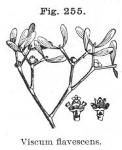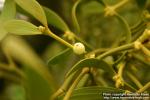Viscum.—Mistletoe.

 Nat. Ord.—Loranthaceae.
Nat. Ord.—Loranthaceae.
COMMON NAMES: Mistletoe, American mistletoe.
Botanical Source and History.—This is the Viscum verticillatum of Nuttall, and Viscum album of Walter. It is a yellowish-green, succulent parasite, growing on the branches and trunks of old trees, especially apple trees, elms, oaks, hickories, etc. The stems are jointed, 1 or 1 ½ feet in length, rather thick, with many round, spreading, opposite, and sometimes verticillate, terete branches. The leaves are opposite, cuneate-obovate, 3-veined, obtuse, smooth, entire, contracted at the base into a short petiole, and 9 to 16 lines long by 4 to 9 broad. The flowers are small, greenish-white; the sterile ones mostly 3-parted, in axillary, solitary spikes, and about as long as the leaves. The fruit is globose, yellowish-white, smooth, semitransparent, with a viscous pulp, is borne in clusters, and contains 1 fleshy seed. It remains throughout the winter (W.—G.).
 Viscum album, Linné, is the European species employed. It differs in the shape of its leaves, which are lance-shaped or spatulate. It grows upon apple, plum, pear and other fruit trees, as well as upon birches, beeches, poplars, etc.
Viscum album, Linné, is the European species employed. It differs in the shape of its leaves, which are lance-shaped or spatulate. It grows upon apple, plum, pear and other fruit trees, as well as upon birches, beeches, poplars, etc.
Description.—This parasitic shrub is found growing on various trees; but that which is found on the oak is preferred. The bark and leaves have an unpleasant odor, and a mawkish, bitterish taste. The proper time for collection is in November, when it should be gradually dried, pulverized, and kept in a well-stoppered bottle. It should never be kept more than a year, as age impairs its active qualities. The mistletoe growing on the water or black elm (Ulmus nemoralis), and on the water oak (Quercus aquatica), is reputed to possess the most energetic medicinal virtues.
Chemical Composition.—All parts of the plant contain viscin; also called bird-glue; curiously miscalled birdlime (from the German Vogelleim), deriving its name from the fact that it has been used in Germany in catching small birds. It is very adhesive, soft, and elastic, having a greenish or brownish color; insoluble in water and fixed oils, slightly soluble in alcohol, very soluble in ether. According to Henry, the berries contain viscin, green wax, gum, bassorin, brown extractive, salts, etc. P. Reinsch (Neues Jahrbuch f. d. Pharm., Vol. XIV, 1860, pp. 129-153) obtained crude viscin from the berries and the bark. The former yield a purer product, but are difficult to obtain in quantity, as they invariably grow on high trees. The scrapings from the bark are first kneaded with gradually increased quantities of water, which removes gum, albumen, sugar, chlorophyll, tannin, and salts; the residual mass is treated with alcohol, which removes yellow wax; the residual crude viscin is then dissolved by ether, which, upon evaporation, leaves a residue which, when washed with alcohol and water, and heated for some time to 120° C. (248° F.), constitutes pure viscin, a clear, tasteless, and odorless mass of the consistency of honey, and capable of being drawn out into threads. In the above treatment, ether leaves undissolved a mixture of plant fibers and a yellowish-brown, exceedingly sticky mass, which is soluble in oil of turpentine. Reinsch calls it viscaoutchin.
Action, Medical Uses, and Dosage.—Narcotic, antispasmodic, diaphoretic, and tonic. This plant possesses toxic properties. Vomiting, catharsis, with tenesmus and sometimes bloody stools, pupillary contraction, muscular spasm, prostration, coma, convulsions, and death have been reported from eating the leaves and berries. Viscum has been beneficially employed in epilepsy, hysteria, insanity, paralysis, and other nervous diseases. In using this agent, it is always necessary to regulate the condition of the stomach and bowels, and the menstrual discharge, and other faulty secretions, and remove worms, if any are present, previous to its exhibition. It is asserted of some value as an oxytocic, and to restrain postpartum and other uterine hemorrhages. It produces intermittent contractions, and by some physicians, especially Dr. Ellingwood, is declared to be safer, in many respects, than ergot. It is useful in amenorrhoea and dysmenorrhoea. It is also reputed a heart tonic. According to Dr. Tascher, it is a remedy for cardiac hypertrophy and dropsy, associated with enlarged heart. Cardiac hypertrophy, valvular insufficiency, feeble pulse, oedema, dyspnoea, and inability to lie down, were the symptoms of the cases favorably influenced by 20 to 30-drop doses of the fluid extract. Dr. Ellingwood advises it with strychnine to support the weak, irregular, and rapid heart-action, with tendency to collapse, in typhoid fever. It may be given in doses of from 30 to 60 grains, and gradually increased to 3 or 4 drachms, 3 or 4 times a day, and if it produces sleep or other narcotic effects, the doses must be diminished; fluid extract, 10 to 40 drops; specific mistletoe, 1 to 15 minims. Preparations of the fresh plant should be used, as the drug loses its properties when old. The powder is best given in an infusion of valerian.
Specific Indications and Uses.—Determination of blood to brain, flushed face, and oft-recurring headache; tearing, rending rheumatic or neuralgic pains, coming on in paroxysms; weak, irregular heart-action, with dyspnoea, cardiac hypertrophy, and valvular insufficiency.
Related Species.—Loranthus europaeus, Linné. East and south Europe. This is a larger shrub, and thicker than the mistletoe. Its berries are light-yellow, and its bark grayish or deep-brown. Oak and chestnut trees support it. It is the plant alluded to by older writers as the Viscum quercinum.

